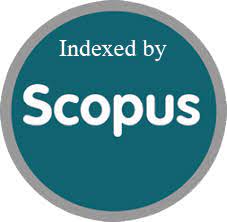Evaluation the role of Interlukin-36 in Atopic dermatitis patients (Eczema)
Keywords:
Atopic dermatitis, IL-36Abstract
Background: Atopic dermatitis (atopic eczema) is a widespread inflammatory skin condition characterized by defects in both skin barrier structures and immune response alternations, so that the major cause for structural abnormalities in the epidermidis associated with immune dysregulation in this disease.
Objective: This study aimed to compare serum IL-36α between 3 study groups and the involvement and importance of these interleukins in atopic dermatitis.
Method: ELISA was used to detect the IL-36 level between groups under study. During the current study, blood samples, were collected from only 60 patients with AD in Diyala and Baghdad province, and 30 healthy persons as a control.
Results: there were significant differences between patients age groups, the highest mean of infection was in the patients and under 30 age categories while the lowest infection mean in control group. the statistical analysis shows the mean of IL-36 in non-treated and treated groups increased significantly when compared with control group. In non-exposure groups IL-36 increased significantly when compared with control group. In Hands & Foot, and Back & Chest groups IL-36 increased significantly when compared with control. The statistical analysis shows the mean of IL-36 in acute, and chronic groups increased significantly when compared with control. The mean of IL-36 in generalized, and localized groups increased significantly when compared with control group. In topical steroid, and systemic groups IL-36 increased significantly when compared with control group. p-value was less than 0.05.
Conclusion: The study demonstrates the role of IL-36 in the pathogenesis of atopic dermatitis and a positive correlation between severity of AD symptoms and level of serum IL-36.
Downloads
Metrics
References
Sroka-Tomaszewska, J.; Trzeciak, M. Molecular Mechanisms of Atopic Dermatitis Pathogenesis. Int. J. Mol. Sci. 2021, 22, 4130.
Hassan, Z. Y., Hassan, T. Y., & Kanany, A. Y. (2024). The Anti-Inflammatory Effect of Chenopodium Murale in Comparison to Salvia Frigida on Atopic Eczema. Journal of the Faculty of Medicine Baghdad, 66(4), 437-445.
Alwan NK, Shakir SA, Waheeb HH. Epidemiology of Skin Diseases among Displaced People in Diyala Province. JFacMedBagdad. 2018; 60(1):52-6. https://doi.org/10.32007/jfacmedbagdad.60145
Alrawiy, E. A. (2022). Atopic Dermatitis Incidence in Iraqi Population and Psychological Side Effects. Int Jr Infect Dis & Epidemlgy, 3(3), 1-3.
Kumar S, McDonnell PC, Lehr R, Tierney L, Tzimas MN. and Griswold DE. 2000. Identification and initial characterization of four novel members of the interleukin-1 family. J Biol Chem. 275: 10308–14.
Khazem R. M. and Ibraheem S. R. Detection of Some Immunological Parameters in Psoriatic Iraqi Female Patients. Iraqi Journal of Science, 2020, Vol. 61, No. 10, pp: 2515-2524
Dinarello C, Arend W, Sims J, Smith D, Blumberg H. and O’Neill L. 2010. IL-1 family nomenclature. Nat Immunol. 11: 973.
Foster, A. M., Baliwag, J., Chen, C. S., Guzman, A. M., Stoll, S. W., Gudjonsson, J. E. and Johnston, A. (2014). IL-36 promotes myeloid cell infiltration, activation, and inflammatory activity in skin. J Immunol, 192 (12): 6053-6061.
Sachen, K. L., Greving, C. N. A., & Towne, J. E. (2022). Role of IL-36 cytokines in psoriasis and other inflammatory skin conditions. Cytokine, 156, 155897.
Al-Ghanmi,H.(2016).Haematological indices and iron status among patients with renal failure in Babylon Governorate.(Master Degree in Scince),University of Kerbala, College of Scince.
Ramirez, F D., Shelley Ch, Sinéad M. L, Aric A. P, Charles E. Mc, Sharon A. K, Michael D. Cabana, Mary-Margaret Chren, and Katrina Abuabara. (2019)"Association of atopic dermatitis with sleep quality in children." JAMA pediatrics 173, no. 5: e190025-e190025.
Nutten, S. (2015). Atopic dermatitis: global epidemiology and risk factors. Annals of nutrition and metabolism, 66(Suppl. 1), 8-16.
Zysk, W.; Sitko, K.; Tukaj, S.; Zarycza´ nska, A.; Trzeciak, M. Altered Gene Expression of IL-35 and IL-36α in the Skin of Patients with Atopic Dermatitis. Int. J. Mol. Sci. 2024, 25, 404.
Kozo Nakai, Yasuo Kubota, and Chie Kohchi (2019). The effect of lipopolysaccharide-containing moisturizing Cream on Skin Care in Patients with Mild Atopic Dermatitis. 33(1), 109-114.
Tsoi LC, Rodriguez E, Stölzl D, Wehkamp U, Sun J, Gerdes S, et al. Progression of acute-to-chronic atopic dermatitis is associated with quantitative rather than qualitative changes in cytokine responses. J Allergy Clin Immunol. 2020;145:1406–15.
Hachem, J. P., Wagberg, F., Schmuth, M., Crumrine, D., Lissens, W., Jayakumar, A., & Egelrud, T. (2006). Serine protease activity and residual LEKTI expression determine phenotype in Netherton syndrome. Journal of Investigative Dermatology, 126(7), 1609-1621..
Downloads
Published
How to Cite
Issue
Section
License

This work is licensed under a Creative Commons Attribution 4.0 International License.
You are free to:
- Share — copy and redistribute the material in any medium or format
- Adapt — remix, transform, and build upon the material for any purpose, even commercially.
Terms:
- Attribution — You must give appropriate credit, provide a link to the license, and indicate if changes were made. You may do so in any reasonable manner, but not in any way that suggests the licensor endorses you or your use.
- No additional restrictions — You may not apply legal terms or technological measures that legally restrict others from doing anything the license permits.






